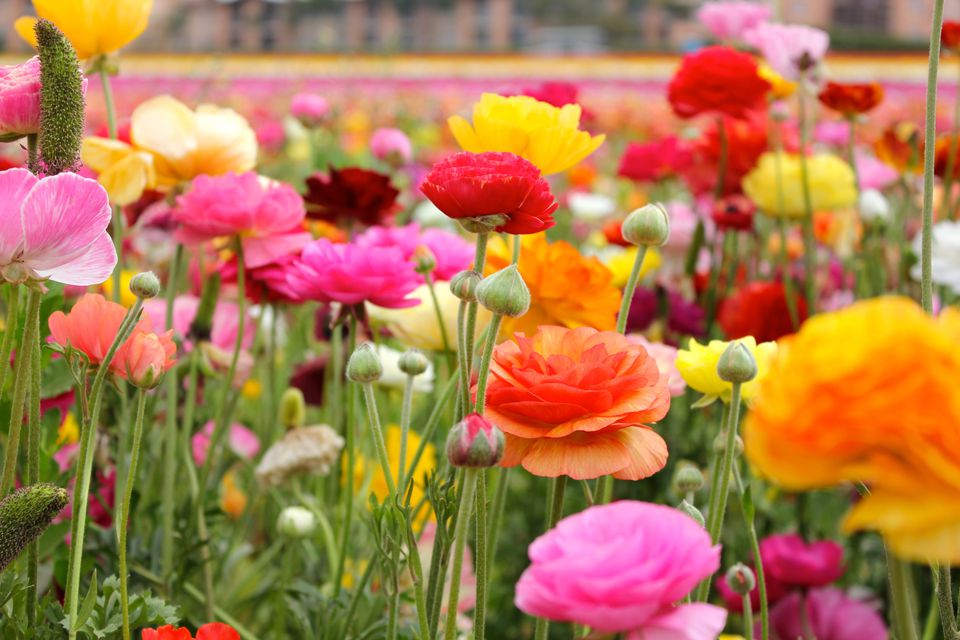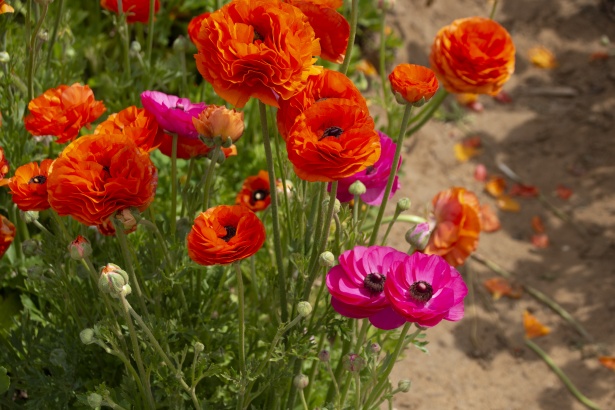
Ranunculi are undoubtedly one of the greatest of the spring bulbs.
They are the happiest of flowers, full of fun and merriment. They provide a very welcome splash of the most honest, brightest and richest of flower colours. Thus if you seek a visually dynamite, stellar and sizzling spring statement, there is no better corm/bulb to plant to celebrate the end of winter. They are a must have for every garden, both large and small.
Regrettably often they are overlooked, even eclipsed, when displayed in packets for sale, jostling for space and attention with the vastly more popular tulips and daffodils.
Every year in late autumn/winter, like seasonal clockwork, I plant a drift or three of new ranunculi.
But this autumn I have grander plans. I want to create a long magical riot of ranunculi, providing a kaleidoscope of vivid colours, pink, orange, white and burgundy. I have just planted over 360 corms. They are not expensive, about $13.00 a pack. My plan is they will perfectly accompany my 10m long drift of self-sown red Flanders poppies intermingled with the odd pink opium poppy.

History
The name ranunculus derives from the Latin word ‘rana’, meaning frog. The plant was so-named since the original ranunculus frequently grew in marshy places inhabited by frogs. However Ranunculus asiaticus (orientalis), is the form commercially available today. They are native to the mountainous regions of South Eastern Europe, Greece and Asia Minor, all generally cool and dry in climate
I vividly remember the first time I ever planted Ranunculus. I was an innocent, naive, yet confident strapping young fellow of eighteen. I was employed to plant a thousand or more of them. The garden is an old, grand and expansive country garden. Provided only with the briefest of instructions from the garden owner of where to plant them, she immediately exited to pursue evidently more urgent and glamorous pursuits. Left alone with no previous experience of planting ranunculus, I was immediately riddled with indecision. Why? It was the dilemma of which way was side up or side down of the corm/claw. After a very long period of procrastination and getting nowhere, something had to happen. Action was required. It was 50/50 gamble, a toss of the coin, heads or tails, claws up or claws down. A determined decision was reached and I proceeded to plant them all. Long weeks passed, nothing happened, not a single leaf emerged anywhere, let alone a flower. Alas I had lost the gamble. I had planted them the wrong way up/down. Woe was me. I faintly recall I may have unconvincedly mumbled to the owner the corms were poor quality. Thankfully I didn’t lose my job in this beautiful garden, and continued work there one day a week for the best of ten years.
The plant is highly poisonous, like nearly all garden plants. Yet to date, I have never heard of a death due to the consumption of ranunculus.
Cultivation
To be very clear you plant the corm/claw downwards. Way back when, as you well know, I learnt this fact the hard way. Plant them in relatively friable soil or in pots with a quality potting mix. Ensure they receive a good, generous amount of winter/spring sun to guarantee germination and optimum flowering and bingo you have a magical floral masterpiece.
Through experience I treat them as annuals. The corms are so small and when dormant, you seem to lose them throughout the year because of digging and weeding in their area. Happily a few will magically naturalise and reappear the next year, but alas not very many. Thus I replant them each year and hopefully so will you.
Good luck and happy plantings,
Ned McDowell